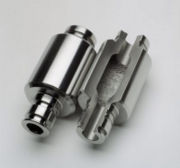Difference between revisions of "Virtual designs into physical objects/Intro"
| (9 intermediate revisions by 2 users not shown) | |||
| Line 1: | Line 1: | ||
| − | [[Image: | + | [[Image:Engine part m.jpg|180px|right|3D printed metal engine component]] At some point virtual designs such as [[Free and open-source computer-aided design/What is computer-aided design|Computer-aided design]] (CAD) models, need to be turned into physical objects, which unfortunately isn't as straightforward as downloading software from a website. Building, testing and modifying physical designs requires effort, time and material cost, although with access to emerging flexible computer-controlled manufacturing (digital fabrication) this complexity and effort becomes drastically reduced and highly repeatable. |
| − | + | Some of the ways that collaborative designs created on a computer can be physically forged range from getting your hands dirty and crafting it yourself, to sending the design, or at least parts of it, as an electronic file to an increasing number of computer-controlled manufacturing systems such as [[rapid prototyping machines|rapid prototyping]] or advanced multi-axis {{wp|CNC|CNC machines}} that can accurately create parts in 3D in a variety of materials. | |
| − | + | ||
| − | + | ||
What is illustrated in this section is that the world of atoms is starting to catch up with the world of bits in terms of ease of control and duplication. '''We are entering the age of digital manufacturing.''' Objects and machines are boiled down to pure information which can be instantly transmitted around the world and recreated physically wherever these 'fabbers' exist. Here are some of the increasing number of methods available to bring virtual designs to life... | What is illustrated in this section is that the world of atoms is starting to catch up with the world of bits in terms of ease of control and duplication. '''We are entering the age of digital manufacturing.''' Objects and machines are boiled down to pure information which can be instantly transmitted around the world and recreated physically wherever these 'fabbers' exist. Here are some of the increasing number of methods available to bring virtual designs to life... | ||
Latest revision as of 00:37, 3 January 2012
At some point virtual designs such as Computer-aided design (CAD) models, need to be turned into physical objects, which unfortunately isn't as straightforward as downloading software from a website. Building, testing and modifying physical designs requires effort, time and material cost, although with access to emerging flexible computer-controlled manufacturing (digital fabrication) this complexity and effort becomes drastically reduced and highly repeatable.Some of the ways that collaborative designs created on a computer can be physically forged range from getting your hands dirty and crafting it yourself, to sending the design, or at least parts of it, as an electronic file to an increasing number of computer-controlled manufacturing systems such as rapid prototyping or advanced multi-axis CNC machines  that can accurately create parts in 3D in a variety of materials.
that can accurately create parts in 3D in a variety of materials.
What is illustrated in this section is that the world of atoms is starting to catch up with the world of bits in terms of ease of control and duplication. We are entering the age of digital manufacturing. Objects and machines are boiled down to pure information which can be instantly transmitted around the world and recreated physically wherever these 'fabbers' exist. Here are some of the increasing number of methods available to bring virtual designs to life...
